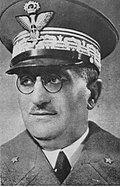This article needs additional citations for verification .(September 2022) |
| Marshal of Italy Maresciallo d'Italia (Italian) | |
|---|---|
 Army rank flag | |
 Marshal of Italy sleeve rank insignia (1933–45) | |
| Country | |
| Service branch | |
| Formation | 4 November 1924 |
| Abolished | 18 January 1947 |
| Next higher rank | First Marshal of the Empire |
| Next lower rank | Army general |
| Equivalent ranks | Grand admiral Marshal of the air force |
Marshal of Italy (Italian : Maresciallo d'Italia) was a rank in the Royal Italian Army (Regio Esercito). Originally created in 1924 by Italian dictator Benito Mussolini for the purpose of honoring generals Luigi Cadorna and Armando Diaz, the rank was granted to several other general officers from 1926 to 1943. The rank was the highest in the Italian Army prior to the creation of the rank of First Marshal of the Empire in 1938. The rank of Marshal of Italy was abolished in 1946 with the creation of the Italian Republic. The equivalent Royal Navy ( Regia Marina ) rank was Grand admiral (Grande Ammiraglio), while the equivalent Air Force ( Regia Aeronautica ) rank was Marshal of the Air (Maresciallo dell'Aria). [1]
Contents
The rank was formally abolished on 18 January 1947 by the Provisional Head of State Enrico de Nicola. [2]
















